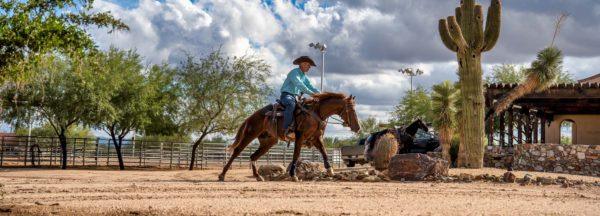Training Tip: Be the Loudest Voice in Your Horse’s Head

When you work with your horse, everything in the environment screams for his attention. This is especially true when you take your horse away from home, whether that’s for a trail ride or to a horse show, because he’s not used to the surroundings. As prey animals, horses notice every little change and keep an eye on what’s going on around them. It’s programmed into their DNA to constantly be on the lookout for potential predators. Some horses, generally the hotter-blooded horses, are more attentive to their environment, while colder-blooded horses tend to be more passive and less likely to be bothered by a change of scenery.
So when you take your horse to a new arena, it’s as if he’s got a thousand different voices screaming out to get his attention.
The bright, flashy arena banner says, “Look at me. I’m scary!”
The dog barking alongside the arena fence says, “No, no, no, look at me. I’m scarier!”
The tractor dragging the arena says, “You’re all kidding yourselves. I’m the scariest of all! Look at me!”
When your horse is focused on all of those “voices,” he’s using the reactive side of his brain and is certainly not paying attention to you. That’s when you find yourself in a dangerous situation. A horse that uses the reactive side of his brain is nervous, unpredictable, spooky and uncontrollable. It doesn’t take much for a reactive horse to eye the barking dog and wheel around in the opposite direction and take off bucking and farting.
If you want to stay safe and accomplish anything with your horse, you have to be the loudest voice in his head and get him to use the thinking side of his brain. In other words, you need to override everything that’s screaming for his attention. You’re more important than the sign, the barking dog and the tractor dragging the arena.
How do you get a horse to tune in to you and use the thinking side of his brain? By moving his feet forwards, backwards, left and right and constantly changing directions. The more changes of direction you ask him to do, the more he has to pay attention to how you’re asking him to move his feet. Horses can only focus on one thing at a time. Your horse is either focusing on what you’re asking him to do or the distractions around him.
Here’s the catch, though. If you have any chance of drowning out all of those distractions, you can’t tiptoe around about it. You have to lead with authority and demand your horse’s attention. That means that you need to move his feet with confidence, not halfheartedly ask him to walk a circle while he continues to eye the banner whipping in the wind. You need his attention NOW.
The next time you find yourself in a situation in which it feels as if a million distractions are pulling your horse’s attention away from you, remember to lead with confidence and be the loudest voice in his head.
Looking for more training tips? Check out the No Worries Club. Have a training question? Send it to us at [email protected].
